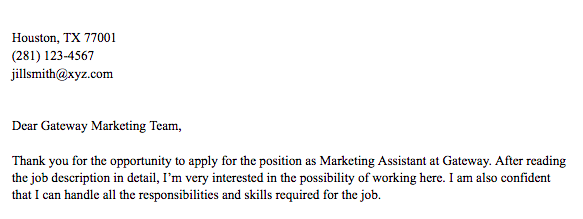In some ways, applying for jobs has never been easier. With the ease of ‘one-click to submit’ job applications on sites like LinkedIn and Indeed, job seekers can apply to multiple jobs in minutes.
But that doesn’t mean you should.
While it may be tempting to simply upload a pre-saved resume and click submit, it’s important to customize your application to every job. Most roles receive hundreds, if not thousands, of applications, So it’s critical that you stand out – and one way to do that is through your cover letter.
A well-written, customized cover letter shows potential employers you’re enthusiastic about the position and have taken time to think about why you are particularly suited for the job. Don’t skip this important step of the application process just because you can.
Writing a strong cover letter doesn’t have to be overly complicated, but you do want to follow a few important points. Make sure it adds something new or different about you that’s not conveyed in your resume. According to Indeed, a well-crafted cover letter “can explain irregularities in your employment, short-term positions, and even incomplete degrees.” Be thoughtful about what you include and most importantly, do not resort to a generic template— especially one that starts by addressing “To Whom It May Concern.”
If you don’t take the time to do a little research upfront, it will show the hiring manager you’re not that invested in the role, even if you say otherwise.
With the proliferation of social media and robust company websites, it’s not difficult to find information about a particular role or department. Ideally, you want to find the name of the person you should address. Otherwise, there are several ways to show you’ve done your homework and avoid the dreaded “To Whom It May Concern.”
There is a hierarchy to the cover letter salutation.
When considering the cover letter salutation, there is a hierarchy of options you should follow. Think of it as a funnel starting with the most specific option down to the least specific, depending on what information you can find. At the top is the name of the person who is hiring. At the bottom, is a general salutation to the hiring manager.
Give your best effort to follow these guidelines so you can stand out from the crowd.
Best Option: Address the name of the person who is hiring.

Instead of using “To Whom It May Concern,” use the name of the person who is hiring.
In the best-case scenario, the name of the person hiring is listed somewhere in the job description. More often than not though, the most you’ll find is something like “this role reports to the Director of Communications.” If so, go to the company website and see if you can find a staff directory or try LinkedIn or Twitter.
If you’re running out of luck, you may be able to find a company phone number. You can try calling and asking for the name of the person hiring for your role. You may not get anywhere but you don’t have to give your name either. No harm done.
If you have a name, always air towards a more formal salutation like “Dear Ms. Smith.” Unless you’ve had a conversation with the person or know them personally, do not start with “Hi Jen.” They may prefer their full name or some other nickname and simply using the first name suggests a familiarity that may put them off. Similarly, be careful not to misgender the person. If their name is gender-neutral, you can start by writing “Dear [first and last name].”
Some companies purposely don’t list a staff directory and make it difficult to find this kind of information. Only use the name if you’re certain you have it right. If not, move to the next level of the hierarchy.
2nd Best Option: Address the head of the department that is hiring.
For many jobs, it is clear which department the job falls under. For example, while the head of the sales department might not actually be the one hiring, they are likely in charge of whoever is — even if indirectly. By addressing the department head, you’ll show you’ve made some effort to figure out to whom you should direct your letter.
Again sometimes this information will be explicitly stated in the job description or otherwise obvious. If not, consult the company website. The website directory or contact information may yield the best results.
Unsure about the name of the department head? Go to the next step.
3rd Best Option: Address the department that is hiring.
While this is a bit more generic, it still demonstrates you understand the team with which you’d be working. “Dear Sales Department” might sound a bit odd, but it’s better than addressing a black hole.

Use the name of the job department or team as your salutation.
4th Best Option: Address the recruiter.
Many companies now have dedicated recruitment or talent acquisition departments in charge of the hiring practice. You won’t be working with these folks directly (unless you’re applying to a recruitment position), but you will work with someone in charge of talent during the hiring and onboarding process. Try to find the name of the recruiter responsible for filling the position.
5th Best Option: Address the recruiting department.
If your search for the recruiter’s name comes up empty, you can start your cover letter by addressing the company’s recruiting department. Use the company’s name and the proper term for their hiring team (like “Dear Recruiting Department” or “Dear Talent Acquisition”) to show you aren’t simply reusing the same cover letter again and again.
6th Best Option: Address the hiring team.
Because there is usually a team of people responsible for one open position, including someone from recruitment and one or a few people from the department that is hiring, you can also address your cover letter to the entire hiring team. Include the role to which you are applying for a bit more specificity. For example, “Dear Communications Specialist Hiring Team/Committee” is preferable to “Dear Hiring Team/Committee.”

Address the hiring team if there are no other options.
When applying for a job, you want to convey a sense of enthusiasm for the company and your unique fit for the role. It’s almost impossible to do so with only generic statements. From the first salutation, show that you know the company and have taken the time and effort to understand who you will be speaking with during the hiring process.
No hiring manager wants to be addressed with an impersonal and lazy “To Whom It May Concern.” No job seeker wants to be eliminated by such a fixable mistake. Be as specific as possible in your cover letter salutation so you can move forward and showcase your skills and talent.
Need help crafting the perfect cover letter?
Our ResumeSpice career consultants would love to help you craft the perfect cover letter. Reach out today by phone – 832.930.7378 – or contact us online to set up a time. Ready to move forward? You can purchase a personalized cover letter here. We’d love to work with you!






